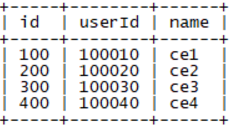1-2 包子mysql系列, 对mysql的innoDB加锁分析
Posted 何锦彬的博客
tags:
篇首语:本文由小常识网(cha138.com)小编为大家整理,主要介绍了1-2 包子mysql系列, 对mysql的innoDB加锁分析相关的知识,希望对你有一定的参考价值。
innoDB的事务,是基于锁来实现的,用到事务不自然就会用到锁,而如果对锁理解的不通透,很容易造成线上问题。
数据库加锁的分析,和事务的引擎,隔离级别,索引,主键索引都有关系,
如果去考虑引擎和各种隔离级别的话,就会很复杂了,所以下面都是基于innoDB和RR的隔离级别进行分析:
表结构:

内容:

1 , 根据主键更新
如果根据主键来行数
|
事务A |
事务B |
|
|
update user set name=‘ce1‘ where id=‘1‘; |
update user set name=‘ce3‘ where Id=‘3‘; |
同时执行,都成功 |
|
update user set name=‘ce1‘ where id=‘1‘; |
update user set name=‘ce3‘ where userId=‘10003‘; |
B更新失败,直至:Lock wait timeout |
结论,如果根据非主键来更新,会把整个表进行锁定,无法 进行更新操作。
注:只要是根据主键索引来更新,哪怕事务A没命中主键,也不会锁定整个表
2,根据非索引非主键更新
|
事务A |
事务B |
|
|
update user set name=‘ce1‘ where userId=‘10001‘; |
update user set name=‘ce3‘ where Id=‘3‘; 或者 update user set name=‘ce3‘ where userId=‘10003‘ |
都会失败,如果非索引,直接锁表 |
3, 如果在userId 列上加入普通唯一索引
修改成

再更新
|
事务A |
事务B |
|
|
update user set name=‘ce1‘ where userId=‘10001‘; |
update user set name=‘ce3‘ where Id=‘3‘; 或者 update user set name=‘ce3‘ where userId=‘10003‘ |
都会成功,如果有唯一索引,也是能成功行数,互相不影响 |
4, 如果在userId 列上加入普通非唯一索引 (重点探讨)
把userId改成非唯一索引:

记录内容如下:
+----+--------+------+
| id | userId | name |
+----+--------+------+
| 1 | 10001 | ce1 |
| 2 | 10002 | ce2 |
| 3 | 10001 | ce3 |
| 4 | 10004 | ce4 |
+----+--------+------+
再相同操作
|
事务A |
事务B |
|
|
update user set name=‘ce1‘ where userId=‘10001‘; |
update user set name=‘ce3‘ where Id=‘3‘; |
B失误执行失败,显然id=3的这行也被锁住了 |
其实最终还是按主键锁住的记录 id=1和id=3的记录
非唯一索引与普通索引,更一步的区别是GAP锁
gap锁是用于解决幻读的存在,演示
把记录修改成,如:

id为pk. userId为Normal key
|
A事务 |
B事务 |
结果 |
|
begin;
update user set name=‘ce22‘ where userId=‘100020‘; |
||
|
insert into user (userId,name) values(‘100021‘,‘tttt‘); |
直至事务失败超时 |
1, 首先GAP锁针对的是insert操作
2, 当更新userId=‘100020‘时,会锁住两边的记录区间,防止幻读的存在。
3, 锁是作用在普通索引上,但由于索引是由B+树存储,那么锁住的是两边的区间,防止insert
GAP锁为什么不是锁住一条记录,而是锁住一个区间呢?
附上疑问: https://www.oschina.net/question/867417_2289606
其实:
GAP锁是解决幻读存在的,如当 delete时就必须锁住区间了
|
A事务 |
B事务 |
|
|
begin;
delete from user where userId=‘888888‘; |
||
|
insert into user (userId,name) values(‘100021‘,‘tttt‘); |
OK, 可以插入 |
|
|
insert into user (userId,name) values(‘100041‘,‘tttt‘); |
插入超时 |
可见,这个GAP锁,锁住的是100040~无穷大 的记录
死锁的产生分析:
1, 两条语句产生的死锁
id = pk, userId= key
最简单的。两条语句互相更新等待
|
begin;
update user set name=‘ce1‘ where userId=‘100010‘; |
begin;
update user set name=‘ce2‘ where userId=‘100020‘; |
|
update user set name=‘ce2‘ where userId=‘100020‘; |
update user set name=‘ce1‘ where userId=‘100010‘; |
|
最简单的死锁 |
2, 由于gap锁,删除一台不存在的记录
如,先删除一条记录,然后插入一条记录, 如果记录GAP锁冲突,两个事务容易互为死锁。如:
|
A事务 |
B事务 |
|
begin; delete from user where userId=‘100020‘; (Query OK, 1 row affected) |
begin;
|
|
|
delete from user where userId=‘565656‘; |
|
insert into user (userId,name) values(‘100041‘,‘tttt‘); |
|
|
insert into user (userId,name) values(‘100019‘,‘tttt‘); |
结果直接抛出:
ERROR 1213 (40001): Deadlock found when trying to get lock; try restarting transaction
分析:
A事务 delete 加入gap锁【100010,100020】, 第二段【100020,100030】
B事务 delete加入gap 锁【100040,无穷大】
然后A事务插入,获取插入意向锁时B事务的GAP锁被阻塞
B事务插入,获取插入意向锁时时被A事务的GAP锁阻塞
结果死锁
以上是关于1-2 包子mysql系列, 对mysql的innoDB加锁分析的主要内容,如果未能解决你的问题,请参考以下文章